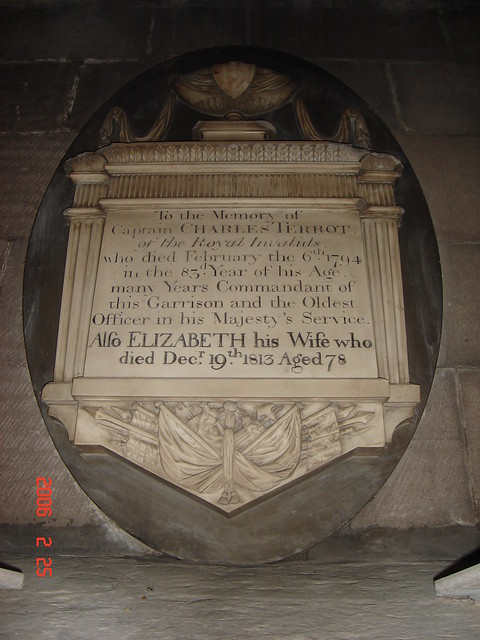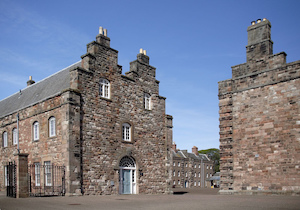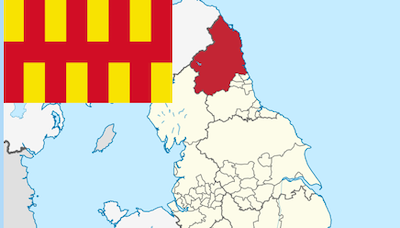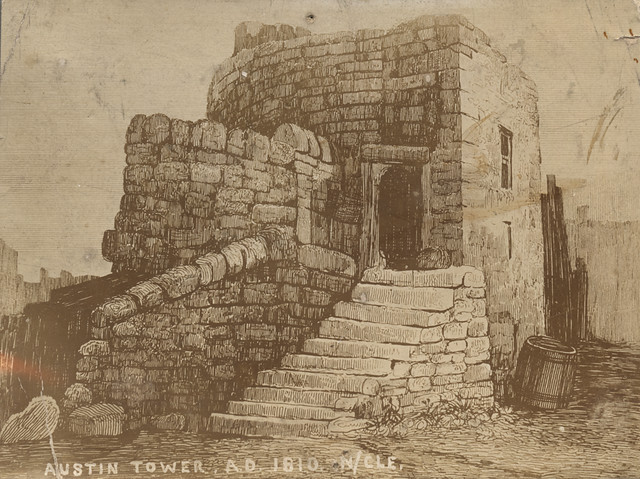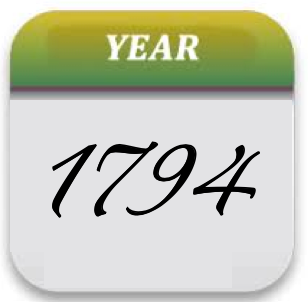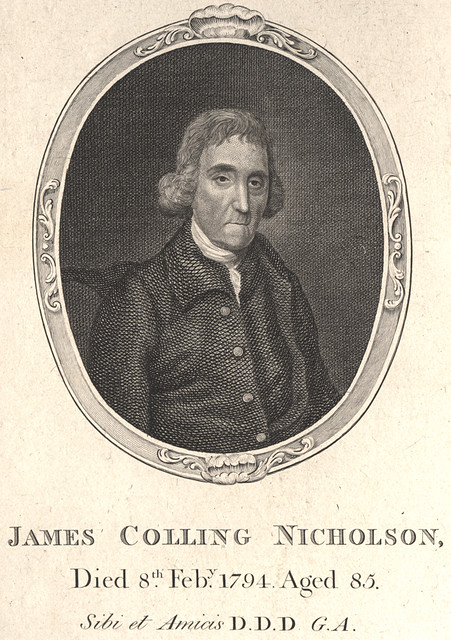Interesting monument - to Captain Charles Terrot of the Royal Invalids, Commander of the Berwick Garrison and the oldest officer in His Majesty's service, who died in 1794, and his wife Elizabeth who died in 1813.

-
Description
- inside the only Church to be built in England during the period of the Commonwealth, erected 1652 in Berwick upon Tweed in Northumberland. Terrot, Charles Hughes (DNB00) (1758-1839) Dictionary of National Biography, 1885-1900, Volume 56 Terrot, Charles Hughes by George Stronach Terry, Daniel TERROT, CHARLES HUGHES (1790–1872), bishop of Edinburgh, born at Cuddalore on 19 Sept. 1790, was a descendant of a family which the revocation of the edict of Nantes drove from France. His father, Elias Terrot, a captain in the Indian army, was killed at the siege of Bangalore a few weeks after the child's birth. His mother, whose maiden name was Mary Fonteneau, returned to England and settled with her son at Berwick-on-Tweed. When nine years old he was placed for his education under the charge of the Rev. John Fawcett of Carlisle. In 1808 he entered Trinity College, Cambridge, where he was an associate of Whewell, Peacock, Rolfe, Amos, Mill, and Robinson. He graduated B.A. in 1812 with mathematical honours, and was elected a fellow of his college. In 1813 he was ordained deacon, and in 1814 was instituted to Haddington, where the leisure of a country incumbency gave him opportunity of competing for university literary honours, and in 1816 he obtained the Seatonian prize for a poem entitled ‘Hezekiah and Sennacherib, or the Destruction of Sennacherib's Host.’ In 1819 he followed this up with another poem, ‘Common Sense,’ in which the poets and politicians of the day were criticised in the style of the ‘Dunciad’ and the ‘Rolliad.’ He then abandoned poetry for theology and mathematics. In 1817 he was promoted to the charge of St. Peter's, Edinburgh, as colleague to James Walker (afterwards bishop of Edinburgh). In 1829 he succeeded Walker as sole pastor. In 1833 he became junior minister of St. Paul's, Edinburgh. In 1836 he was appointed synod clerk of the diocese, in 1837 dean of Edinburgh and Fife, in 1839 rector of St. Paul's, and in 1841 bishop of Edinburgh and Pantonian professor. In 1856 a church was built for him on the scene of his labours in the old town. On the death of William Skinner (1778–1857) [q. v.], bishop of Aberdeen, in 1857, Terrot was chosen primus of Scotland, an office which he held till a stroke of paralysis compelled his resignation in 1862. He died on 2 April 1872, and was interred in the Calton burying-ground. Terrot was twice married: first, in 1818, to Sarah Ingram, daughter of Captain Samuel Wood of Minlands, near Berwick-on-Tweed. She died on 9 Sept. 1855. He married, secondly, in 1859, a widow, Charlotte Madden, who died in February 1862. By his first wife he had fourteen children, six of whom predeceased him. His eldest daughter accompanied Miss Florence Nightingale to the Crimea, and was afterwards decorated with the royal red cross in recognition of her services. Terrot was an excellent mathematician, and was for fourteen years a fellow of the Royal Society of Edinburgh, to whose ‘Transactions’ he contributed numerous papers on mathematical subjects. He was also a member of the Architectural Society of Scotland, and delivered the annual introductory address on 29 Nov. 1855. Besides separate charges and sermons, Terrot wrote: 1. ‘Pastoral Letters,’ Edinburgh, 1834, 8vo. 2. ‘Two Series of Discourses, on i. Christian Humiliation; ii. The City of God,’ London, 1845, 8vo. 3. ‘Sermons preached at St. Paul's Episcopal Church, Edinburgh,’ Edinburgh, 1865, 8vo. He edited the Greek text of ‘The Epistle to the Romans, with an Introduction, Paraphrase, and Notes’ (London, 1828, 8vo), and translated Ernesti's ‘Institutio Interpretis,’ in two volumes, entitled ‘Principles of Biblical Interpretation’ (Edinburgh, 1832–3, 8vo). [Three Churchmen, by W. Walker, 1893 (with portrait); Crombie's Mod. Athenians; Proc. of Royal Soc. of Edinb. viii. 9–14 (obit. notice by Professor Kelland); Scotsman, 3 and 4 April 1872; Memoir by Dean Ramsay in Scot. Guardian, 15 May 1872; Cat. of Advoc. Libr.; information supplied by Miss Terrot, the bishop's daughter.] " Also from Wikisource Terriss, William Dictionary of National Biography, 1885-1900, Volume 56 Terrot, Charles (1758-1839) by Robert Hamilton Vetch Terrot, Charles Hughes TERROT, CHARLES (1758–1839), general royal artillery, was born at Berwick-upon-Tweed on 1 May 1758. He entered the Royal Military Academy at Woolwich on 15 March 1771, and received a commission as second lieutenant in the royal artillery on 1 March 1774. He went to North America in 1776 and joined Sir Guy Carleton in May at Quebec, Canada. He served under Brigadier-general Fraser at the action of the Three Rivers on 7 June, when the American attack was repulsed, and the Americans, having been driven with great loss to their boats on Lake St. François, fell back on Ticonderoga. In June 1777 Terrot was with the army of General Burgoyne which pushed forward from Canada by Lake Champlain to effect a junction at Albany with Clinton's forces from New York. Burgoyne reached Ticonderoga on 1 July, and invested the place. On 6 July the Americans evacuated it, and Terrot took part in the capture of Mount Independence and the other operations following the American retreat. On the departure of Burgoyne for Still-water, Terrot was left under Brigadier-general Powel at Ticonderoga, where he commanded the artillery. This place and Mount Independence were attacked on 18 Sept. by the Americans under Colonel Brown, who had surprised a small sloop and the transport boats, and captured a detachment of the 53rd regiment. The attack lasted four days, at the end of which the Americans were beaten off. After Burgoyne's surrender at Saratoga, Terrot returned to Canada. On 7 July 1779 he was promoted to be first lieutenant. In 1780 he went to Lake Ontario with two 6-pounders in an expedition under Sir John Johnston; but circumstances altered their destination when on the lake, and Terrot remained at Niagara for nearly four years, principally employed as an assistant military engineer. The works of defence at Niagara were completely repaired under his supervision. In 1782 he surveyed the country between Lakes Erie and Ontario with a view to its purchase by the government from the Indians, and to mark out its boundaries. He afterwards conducted the negotiations with the Indians with complete satisfaction to them and with great advantage to the government. On 8 March 1784 he was promoted to be second captain when he returned to England, and served at various home stations with his company. In 1791 Terrot volunteered for service in the East Indies, and arrived on 10 Oct. at Madras with two companies of royal artillery, of which he was quartermaster. He joined the army of Lord Cornwallis at Savandrug on 12 Jan. 1792, and was attached to the artillery park. He took part on 6 Feb. in the night attack on, and capture of, Tipu Sultan's fortified camp, on the north side of the Kaveri river, covering Seringpatam, and in the siege of that city until terms of peace were agreed to. He marched on 26 March with the army which reached Madras at the end of May. On the declaration of war by France against Great Britain, measures were taken to seize the different French factories in India. In August 1793 Terrot was employed against Pondicherry, and when the governor, Colonel Prosper de Clermont, on being summoned, refused to submit, he took part in the bombardment of 20 Aug. and in the siege, which, however, lasted only till the 23rd of that month, when the place capitulated. Terrot was promoted to be first captain on 25 Sept. 1793, and returned to England. On 1 March 1794 Terrot was promoted to be brevet major for his services, and appointed to a command of artillery at Portsmouth. On 1 Jan. 1798 he was promoted to be brevet lieutenant-colonel, and in the following year was employed in the expedition to the Helder. He accompanied the first division under Sir Ralph Abercromby, landing on 27 Aug., and took part in the fighting on 10 Sept., in the battle of Bergen on 19 Sept. under the Duke of York, at the fight near Alkmaar on 2 Oct., and the affair of Beverwyk on 6 Oct. Terms having been settled with the French, Terrot returned in November to England; he was shipwrecked near Yarmouth harbour, and, although all lives were saved by the boats of the fleet, he lost all his effects. On 12 Nov. 1800 Terrot was promoted to be regimental major, and on 14 Oct. 1801 to be regimental lieutenant-colonel. After ordinary regimental duty for some years, he was promoted to be colonel in the royal artillery on 1 June 1806. In July 1809 he accompanied the expedition to the Scheldt under the Earl of Chatham, and directed the artillery of the attack at the siege of Flushing, which place capitulated on 15 Aug. Terrot was thanked in orders for his services at Walcheren. Terrot was promoted to be major-general on 4 June 1811. In 1814 he was appointed as a major-general on the staff to command the royal artillery at Gibraltar, in succession to Major-general Smith, but the latter, owing to the death of the governor, succeeded to the command of the fortress, and refused to be relieved. After vainly waiting some months for the arrival of a new governor, Terrot obtained permission to return to England, resigned his appointment, and retired on 25 June 1814 on full pay. He was promoted to be lieutenant-general on 12 Aug. 1819, and general on 10 Jan. 1837. He died at Newcastle-on-Tyne on 23 Sept. 1839." [War Office Records; Despatches; Gent. Mag. 1839; Duncan's Hist. of the Royal Artillery; Stubbs's Hist. of the Bengal Artillery; Squire's Campaign in Zeeland; Carmichael Smyth's Chronological Epitome of the Wars in the Low Countries; Stedman's American War of Independence; Dunn's Campaign in India, 1792; Minutes of Proceedings of the Royal Artillery Institution, vol. xvi.; Jones's Sieges; Cust's Annals of the Wars of the Eighteenth Century; Kane's List of Officers of the Royal Artillery.] " From "Distinguished Huguenot Refugees and their Descendants" website http://www.godrules.net/library/smiles/95smiles4.htm" >www.godrules.net/library/smiles/95smiles4.htm Terrot : the De Terrots belonged to the petite noblesse, and held property in the neighbourhood of La Rochelle. They were Protestants, and fled into England at the Revocation. Many members of the family have held high offices in the army and the church. Among the former were Captain Charles Terrot (first commission dated 1716); Captain Samuel Terrot, R.A.; Captain Elias Terrot (killed in India); Captain C. E. Terrot, 63rd Regiment; and Colonel Elias Terrot (Indian service). And among the churchmen of the family may be mentioned the Rev. W. Terrot; vicar of Grindon, Durham; the Rev. C. P. Terrot, vicar of Wispington; and the Hon. and Rev. Dr. Charles Terrot, Bishop of Edinburgh. The Rev. William Terrot, above mentioned, was chaplain to the Royal Naval Asylum at Greenwich, and died more than thirty years since. When once asked to sign a petition in favour of Roman Catholic Emancipation, he declined, with the remark that “the Roman Catholics had kicked his family out of France, and he had no wished to be kicked back again.” [http://commons.wikimedia.org/wiki/File:Interesting_monument_-_to_Captain_Charles_Terrot_of_the_Royal_Invalids..jpg" >commons.wikimedia.org/wiki/File:Interesting_monument_-_to...] -
Owner
Bolckow -
Source
Flickr (Flickr) -
License
What does this mean? Attribution-ShareAlike License
-
Further information
Link: https://www.flickr.com/photos/83226190@N00/2255017512/
Resource type: Image
Added by: Simon Cotterill
Last modified: 8 years, 11 months ago
Viewed: 1694 times
Picture Taken: Unknown -
Co-Curate tags
